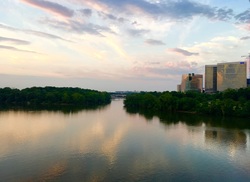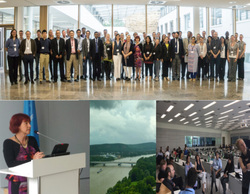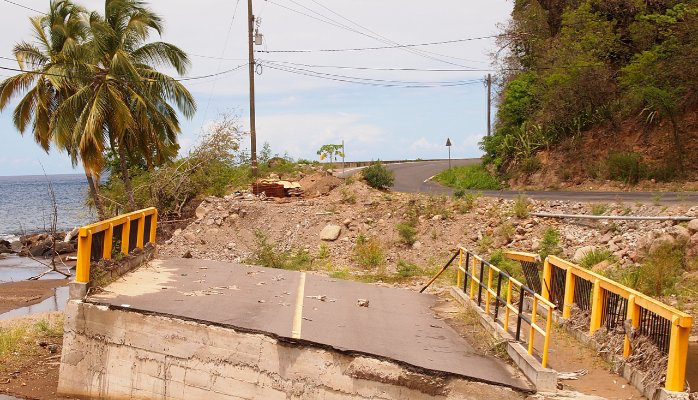 INSIGHTS Practical Information for environmental risks and solutions. Guiding Principles for integrating ecosystems into infrastructure and broadscale solutions for mitigating hazards and climate change Increasingly, we are asked for guidance on how to integrate engineering and ecosystem solutions to hazard, climate change and development decisions. Requests come from across the board at all scales, and noticeably from island nations where decision-makers are responsible for multiple sectors. Mistakes are costly and may not be fixable. Ecosystems provide essential services to humans in mitigating hazards and climate change. Coral reefs, mangroves, wetlands, forested hillsides, and sand dunes can protect humans from hazards like hurricanes, storm surges and landslides. There is growing interest in leveraging these services to create cost-effective solutions that protect human enterprise and communities. The value to humanity from robust ecosystem-based solutions can be huge but the cost from poorly designed ones can be vast, and create a crisis of confidence in the idea of building with nature. In the aftermath of the SE Asia tsunami there was high interest and investment in mangrove restoration. At least 75% of the efforts failed. Poor planning and implementation, planting of mangroves in unsuitable habitats, planting of wrong species are among the reasons for the high failure rate. These kinds of mistakes can be avoided by using guidelines and standards. Here are 10 principles based on experience. Guiding Principles. 1. Do no harm. In a time when nature is under threat, there’s often an unstated assumption that attempts to restore biodiversity and ecosystems carry no negative consequences. But building with ecosystems can have harmful effects if projects are not properly evaluated or carried out. Introduction of non-native species, attempting to establish species or ecosystems in unsuitable habitats, restorations that create future health or economic risks are not positive actions and need to be avoided. Assess the positive and potential negative impacts of any nature-based project. 2. Identify the problem/problems to be solved. It is not unusual for clients or entities to define an important part of a problem the face and fail to articulate their deeper expectations or needs. Defining the problem is more challenging than generally perceived. Spend time in assessing the full suite of issues on the table to be solved, and the role that ecosystems can play in solutions. This will take more time than you imagine but it is one of the most critical steps. Otherwise you may solve the wrong problems or priorities, albeit very well. 3. Identify and assemble the best-qualified team. The previous step (2) will enable you to define the expertise and skillset needed for the team. For instance, when working on endangered species issues as part of a major and controversial restoration, our client initially felt that we needed a panel of endangered species experts to resolve problems associated with their potential extinction and recovery. However, as we worked to understand the issues more deeply, it became clear that involving habitat experts, hydrologists and engineers would be critical to finding a solution. By engaging the best and a complete team we were able to provide real and workable solutions. We were also able to get to solutions quicker because the right team was in place. Be comfortable knowing that you will likely have to reach outside your domain for the right expertise - just because you don’t know it doesn’t mean it’s not important. The right team matters. 4. Listen to the community but be professional. Community concerns, knowledge and wishes must be taken into account. Otherwise the risk of failure is high. However, for modern challenges, these projects need the best of human know-how. They are and should be considered professional undertakings that will involve expert knowledge, high-level skills, and professional judgment. 5. Understand the system or systems. Invest in knowing the system. What are key dynamics, drivers, current conditions and likely system performances overtime and under different scenarios? What ecosystem services are expected? What is the likelihood that the project can deliver them and at what levels of performance and confidence? How will the ecosystem interact with all the other activities and developments? Addressing these kinds of questions generate long-term solutions. 6. Risks and Uncertainty. Be honest with clients and communities about the risks and uncertainties. These are the two elements that most frame their decision space. Individuals and entities are more able and comfortable making decisions when these presented to them. Too often risks are identified without uncertainty or vice versa. Situations where risks are high and there is high uncertainty require different decision-criteria to situations of low risk and high uncertainty. 7. Identify the range of options that offer solutions. Consider tradeoffs, costs, and expectations associated with each option. For instance, an ecosystem-based approach may be at best an experimental solution. This can be a viable and ethical option if the community is informed, on-board, and proper precautions and monitoring are included. Where possible evaluate the benefits and losses associated with an ecosystem-based, a hybrid (ecosystem-engineering mix), or engineering solutions. 8. Address practicalities. How workable are the solutions given factors such as governance, regulations, scale, community acceptance, financing or other restrictions? Evaluate each alternative in relation to practicalities, and articulate the range of solutions to communities and clients. 9. Prepare all elements of the project for implementation. Prepare appropriately, especially when projects require many inter-dependent steps. 10. Monitor and report. Monitor the results. Use an adaptive management approach so that current and future projects can learn from the effort and in order to continually improve decisions and implementation. Report transparently, clearly and often to clients/stakeholders. Deborah M Brosnan Ph.D.
0 Comments
Innovating engineering and ecosystem-based approaches for disaster risk reduction & climate change *6/22/2016  Thoughts from an International Science-Policy Workshop. Recently at the invitation of the UN and PEDRR (Partnership for Environment and Disaster Risk Reduction**), I was fortunate to participate in and facilitate at a small but powerful international gathering on integrating engineering and ecosystems approaches into Disaster Risk Reduction and Climate Change. I flew to Bonn Germany, birthplace of Beethoven, for an intensive three-days of work at the UN Campus. Emerging challenges associated with population growth, urbanization (by 2050 over half the world’s population will live in coastal cities), economic development, sea level rise and changing climate patterns will require fresh approaches and answers. New solutions will need to be innovative and align engineering infrastructure with environmental protection and economic growth. Nature is a critical player but not the only one in this kind of thinking. The concept of nature-based solutions or building with nature is becoming more mainstream as society struggles to find answers and while an expanding population puts more demands on scarce and stressed resources. But not everyone is convinced that nature is as secure as concrete. The Bonn gathering brought together thinkers and practitioners from around the world representing most of the planet’s ecosystems and interests. Experiences spanned national, urban, and rural scales. There were experts in economics, finance, engineering, ecology, social sciences, and from academic, government, NGO, institutional and the private sectors. All had an important voice. Integrating ecosystem services with engineering is necessary but complex. Some nations have already embraced the concept and invested heavily to explore solutions. In the Netherlands, government, private and academic sectors joined together with an investment of $30million over five years to collaborate on this challenge. The U.S. Army Corps of Engineers, known for its huge infrastructure projects, has been exploring guidelines and approaches to include nature in their designs. NGO communities like The Nature Conservancy, Environmental Defense Fund, Wetlands International and others have actively been supporting nature-based solutions. Japan has been learning from post Tohoku efforts. Academics and university programs like UN-University, the Global Forum for Urban and Regional Resilience (Virginia Tech), programs in Singapore, Spain, Germany and beyond have sought to facilitate dialogues and cross-disciplinary interactions as well as engaging in research projects. Professional engineering societies, e.g. American Society of Civil Engineers, are seeking ways to adapt their practices to include green solutions and address climate change. The UN and PEDRR continue to provide a forum for these efforts. For three full days we worked in plenary and small groups, holding spirited debates to explore the challenges and identify action priorities that would help us to get closer to solutions. Participants shared their knowledge and opinions. They described on the ground experiences from large to small-scale projects, lessons learned, and views on how to make progress ranging from integrated design to procurement practices. I facilitated the first day of discussion on engineering and ecological guidelines, and approaches. While engineers work to well-honed specifications seeking a fixed and stable outcome, ecosystem scientists focus on processes, their approach is to facilitate ecosystem dynamics that will result in habitat changes over time. A challenge is to bring these two kinds of systems and thinking together. Codes of practice, issues of client versus beneficiary, liability, reliability, and community engagement were much discussed. Ecological-Engineering is a multi-functional effort and one that will require long-term focus and demonstration pilot projects. It is critical to be clear to communities and clients the benefits and losses associated with ecosystem only, engineering only, and hybrid (ecosystem-engineering) solutions. Cost is always a driver of what is possible. Engineering solutions can mean higher building and maintenance cost compared to nature-based or hybrid ones. The question is whether the costs are justified for the benefits, or whether risks are perceived as too great to leave the solution to nature. Communities vary in their knowledge of nature, their uses of their natural resources, and the level of risks that they are willing to bear. Balancing the input of community knowledge with professional approaches and implementation needs to be considered. Nature-based projects should not be based only on local volunteerism since they require professional expertise and often involve large engineering works. Economic costs, incentives and financing for solutions will play a driving role in whether the best options are implemented or not. Five umbrella priority Items were identified by the group for deeper exploration by the PEDRR partnership and participants themselves. Before the end of the gathering each group had identified specific next steps, with timelines and responsible parties. Everyone felt the urgency to move from ideas to action. The overarching priorities are briefly summarized as:
In the city of Beethoven we did not compose a musical masterpiece, we did however collectively create a dynamic symphony with disparate but harmonic voices working towards a common opus. Deborah Brosnan Ph.D *Thank you to the UN and PEDRR especially to Marisol Estrella, Fabrice Renaud, Karen Sudemeir, Muralee Thummarukudy, Zita Sebesvari and Jakob Rhyner, who were instrumental in conceiving and organizing this effort. My deep appreciation to all who participated and engaged. Personal opinions are my own. This is an inclusive effort that welcomes the participation of professionals and societies who can and wish to contribute. Please make contact if you are interested in knowing more and/or collaborating **Formally established in 2008, the Partnership for Environment and Disaster Risk Reduction (PEDRR) is a global alliance of UN agencies, NGOs and specialist institutes (pedrr.org). Image, top and bottom left courtesy of PEDRR and Karen Sudermeir, others Debraoh Brosnan. Calling professionals: Bridging ecosystems and engineering with disasters and climate change - share your thoughts. Colleagues. Shortly, I am participating in and facilitating a PEDRR and UN led-effort to better integrate ecosystems and engineering approaches to Disaster Risk Reduction and Climate Change. As many of you know, I work as a marine ecosystems expert in the areas where complex real world challenges call for multi-pronged solutions. The connection between ecosystems and engineering creates opportunity for unifying these areas to build a safer and more resilient world. But it requires that ecologists and engineers have a framework for working together and a way to generate workable solutions. This is an area where we've been developing linkages and practices for a while and including recently convening workshops/small groups to discuss this topic. Prior to the upcoming gathering, I’m reaching out to invite those in these fields who may have experiences, ideas, burning viewpoints etc.,that you want to contribute. My goal is to learn from an inclusive and broad set of opinions and experiences to better articulate the challenges and opportunities ahead. If you have professional and productive opinions that you want to and are comfortable to share, and please send them to me. Thank you and Kind Regards Deborah Brosnan |
AuthorDeborah Brosnan Archives
December 2019
|


 RSS Feed
RSS Feed